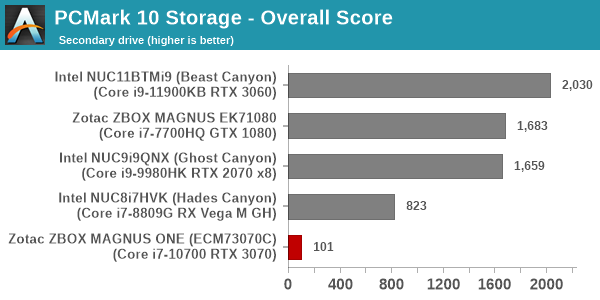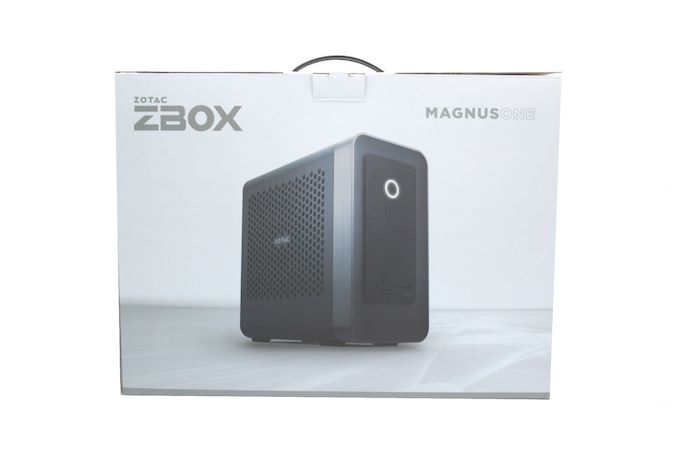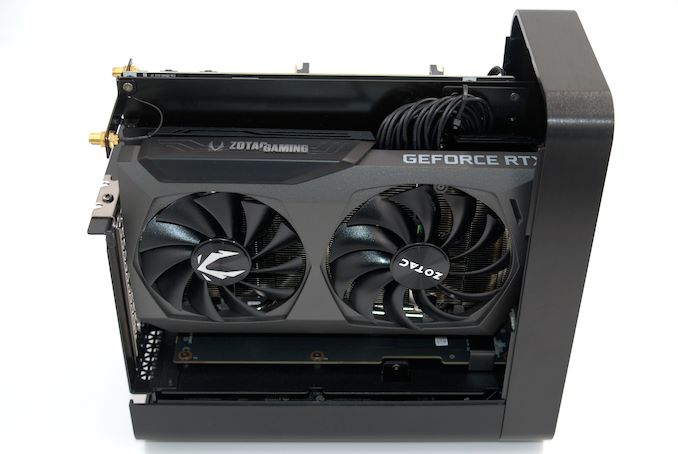Zotac ZBOX MAGNUS ONE SFF Gaming PC Review: Desktop Comet Lake Charges Up with Ampere
by Ganesh T S on August 13, 2021 10:00 AM ESTMiscellaneous Aspects and Concluding Remarks
Networking and storage are two major aspects which influence our experience with any computing system. This section presents results from our evaluation of these aspects in the Zotac ZBOX MAGNUS ONE (ECM73070C). On the storage side, one option would be repetition of our strenuous SSD review tests on the drive(s) in the PC. Fortunately, to avoid that overkill, UL PCMark 10 has a Full System Drive Benchmark storage test certain common workloads such as booting, loading games, and document processing are replayed on the target drive. The average access times and bandwidth numbers are recorded for each trace and the overall numbers contribute to a benchmark score.
Since the review configuration is a dual-drive system, we were able to process the benchmark on both the primary and secondary drives. The results are presented below.


The primary drive is a DRAM-less NVMe SSD and delivers good enough performance. The secondary drive is a hard disk (something of a rarity these days). Understandably, its performance is downright abysmal compared to flash-based secondary drives in the other mini-PCs.
On the networking front, Zotac ticks all the right boxes for gamers by integrating the Killer line of wired and WLAN adapters. The Killer adapters come with specific networking features to have fine-grained control over lag, latency, and packet loss - all of which are important for online gaming sessions. The 2.5Gbps port is also a nice upgrade over the regular gigabit ports found in most Comet Lake desktop platforms.
Coming to the business end of the review, Zotac's MAGNUS ONE is undoubtedly one of the most powerful pre-built gaming mini-PCs to appear in the market. The standard configuration leaves one of the SODIMM slots empty and that handicaps the performance of the system. A 2.5" hard disk for bulk storage is welcome in a mini-PC meant for gaming purposes. However, 1TB is too small a capacity for spinning rust in modern systems. It would have been better if Zotac had gone in for one of the 4TB HDDs. Despite these shortcomings, the 4K and 1440p gaming credentials of the system far surpass that of the Ghost Canyon NUC. The Beast Canyon NUC with the Tiger Lake processor is a more capable system, but it is not available in the market yet. The MAGNUS ONE has been selling for the past 6 months and is available for purchase today. More importantly, it is in stock - one of the few ways in which one can get hold of a high-end nVIDIA Ampere GPU without paying a premium to the scalpers.
A key difference between the MAGNUS ONE and the previous MAGNUS flagships is the upgrade aspect. It is the first system that Zotac is advertising with a user-replaceable discrete GPU. As long as the GPU to be installed consumes 220W or lesser, is not longer than 230mm (9.06 in.), and takes up only two slots at the maximum, it is possible for end users to upgrade the pre-installed RTX 3070 a year or two into the system's service lifetime.
Despite lacking premium features such as Thunderbolt 4 or Wi-Fi 6E support, Zotac has made some pleasing decisions in the chassis design such as tool-less access to the internals, ease of installing components, and the presence of easily accessible Type-C and Type-A ports in the front panel. These are aspects that future Extreme NUCs and other gaming mini-PCs would do well to incorporate.
Overall, Zotac has a winner in the MAGNUS ONE. The huge demand for the nVIDIA Ampere GPUs has allowed the company to push out the high-margin pre-built SKU into the market, rather than just selling the barebones version. The system was launched at $1900 back in January, but the same configuration now retails for $2400. The price increase is a bit unfortunate, but the availability of discrete GPUs is such that the market is able to absorb the increased pricing and still keep the product moving along. The positive aspect is that the system built around the RTX 3070 by Zotac hits all the right notes for a capable gaming mini-PC.













19 Comments
View All Comments
erinadreno - Friday, August 13, 2021 - link
Seems quite strange that they opt for an H470 chipset but 10th gen CPU. And that cooler is really pathetic even for a 65W CPU. Reminds me of engine 27 which also has really bad performance.abufrejoval - Friday, August 13, 2021 - link
Sadly all 4TB or greater 2.5" HDDs these days use shingled media: I'm not sure I'd want to recommend those, even for a games library.TheinsanegamerN - Friday, August 13, 2021 - link
Why not?abufrejoval - Friday, August 13, 2021 - link
Take ARK Survival Evolved for example, a game that can easily grow beyond 100GB, especially with extra DLC content. Yet it uses tons of smallish files and receives gigabytes of updates every other week. The write amplification for updating these small files will be cached as long as the drive has enough space and been left powered to re-organize and rewrite its shingles.But once it's too full or kept too busy, updates could slow below what your broadband delivers.
Shingled media delivers a 25% capacity increase. I'd rather pay those 25% and have the choice to use CMR. But that choice is no longer there, on 2.5" HDD it's currently SMR or bust (apart from some leftover stockpiles).
Spunjji - Monday, August 16, 2021 - link
As a concept it really does only make good sense for low-rate-of-change media storage and/or where the OS is explicitly aware of the drive's geometry and has appropriate caching systems in place. The decision to sell these drives directly to consumers wasn't the best.abufrejoval - Friday, August 13, 2021 - link
Thunderbolt support with a dGPU is a mess, because you have to re-route the external display ports to TB. TB4 on Gen10 hardware: Don't know if that's done or possible. TB3 would be quite nice already, but if you can't re-route the display, you won't get certified as Thunderbolt, AFAIK, while may would be fine with having support for 4 external PCIe lanes on such a compact PC.abufrejoval - Friday, August 13, 2021 - link
s/may/many--need editjeremyshaw - Friday, August 13, 2021 - link
A decent number of TB3/4 host add-in cards for desktops have DP input, to enable the video pass through. Even TB3/4 integrated on desktop motherboards will usually have a DP input to enable video passthrough (especially AMD MBs, since many of their top consumer CPUs do not have IGPs).RomanPixel - Friday, August 13, 2021 - link
Good choices for hardware I think. Having a 10th over the 11th will lessen heat as well as choosing a RTX 3000 series card with GDDR6 over GDDR6X VRAM. Not a fan of seeing some hybrid or regular HDD thou. I guess if you got the space, go for it! Or maybe it's justified to so many games becoming around 100GB in size now for storage. | If anyone is making small graphics cards it's Zotac with this RTX 3000 series, I don't think it would have been much possible to be any other board partner.Death666Angel - Saturday, August 14, 2021 - link
I have a 2TB SSD system and games drive with a 2TB SSD data drive for musik, videos, pictures and the likes. I can pretty easily install all my most wanted games, so I wouldn't go for an HDD just for games. I have an external HDD for backups and a NAS for backups and my ripped media. How many 100+GB games does one play each week? :) I haven't needed an HDD for programs/games since my 500GB Samsung 840. But I also don't play 5 different AAA games simultaneously, I guess. :DAnd Zotac is great for small form factor graphics cards. I have their 2070 in a small mATX, great card! They aren't even that much more costly I think.